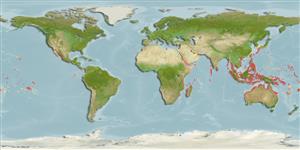>
Ovalentaria/misc (Various families in series Ovalentaria) >
Pomacentridae (Damselfishes) > Pomacentrinae
Etymology: Pomacentrus: Greek, poma, -atos = cover, operculum + Greek, kentron = sting (Ref. 45335).
More on author: Cuvier.
Environment: milieu / Zona climática / intervalo de profundidade / distribution range
Ecologia
marinhas; estuarina associadas(os) a recifes; não migratória; intervalo de profundidade 0 - 3 m (Ref. 7247). Tropical
Indo-West Pacific: Sri Lanka, Andaman Sea (Phuket), and Indo-Australian Archipelago eastward to New Britain, Solomon Islands, Santa Cruz Islands, and Vanuatu.
Tamanho / Peso / Idade
Maturidade: Lm ? range ? - ? cm
Max length : 7.5 cm SL macho/indeterminado; (Ref. 542)
Descrição suscinta
Chaves de identificação | Morfologia | Morfometria
Espinhos dorsais (total) : 13; Raios dorsais (total) : 14 - 15; Espinhos anais: 2; Raios anais : 14 - 15.
Body shape (shape guide): short and / or deep; Cross section: compressed.
A shallow water species, solitary, in holes of small rocks on sandy bottom with coral rubbles. Adults inhabit shallow bays, silty coastal reefs and harbors with sparse coral and algal growth. Feed mainly on benthic algae (Ref. 7247). Oviparous, distinct pairing during breeding (Ref. 205). Eggs are demersal and adhere to the substrate (Ref. 205). Males guard and aerate the eggs (Ref. 205). Diurnal species (Ref. 113699).
Ciclo de vida ou comportamento de acasalamento
Maturidade | Reprodução | Desova | Ovos | Fecundidade | Larvas
Oviparous, distinct pairing during breeding (Ref. 205). Eggs are demersal and adhere to the substrate (Ref. 205). Males guard and aerate the eggs (Ref. 205).
Allen, G.R., 1991. Damselfishes of the world. Mergus Publishers, Melle, Germany. 271 p. (Ref. 7247)
Status na Lista Vermelha da UICN (Ref. 130435: Version 2025-1)
Ameaça para os humanos
Harmless
Uso pelos humanos
Pescarias: pouco comercial
Ferramentas
Relatórios especiais
Baixar XML
Fontes da internet
Estimates based on models
Preferred temperature (Ref.
123201): 24.6 - 29.3, mean 28.4 °C (based on 2864 cells).
Índice de diversidade filogenética (Ref.
82804): PD
50 = 0.5000 [Uniqueness, from 0.5 = low to 2.0 = high].
Bayesian length-weight: a=0.02455 (0.01155 - 0.05216), b=2.98 (2.81 - 3.15), in cm total length, based on LWR estimates for this Genus-body shape (Ref.
93245).
Nível Trófico (Ref.
69278): 2.0 ±0.00 se; based on food items.
Resiliência (Ref.
120179): Elevada, tempo mínimo de duplicação da população menor que 15 meses (Preliminary K or Fecundity.).
Fishing Vulnerability (Ref.
59153): Low vulnerability (10 of 100).
🛈
Nutrients (Ref.
124155): Calcium = 173 [79, 298] mg/100g; Iron = 0.884 [0.497, 1.668] mg/100g; Protein = 18.2 [16.9, 19.4] %; Omega3 = 0.0969 [, ] g/100g; Selenium = 14.4 [6.6, 31.8] μg/100g; VitaminA = 93.1 [21.6, 358.4] μg/100g; Zinc = 2.91 [1.83, 4.86] mg/100g (wet weight);
